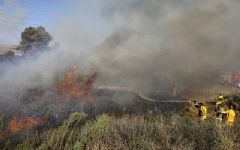Human Rights Voices
While the UN devotes its human rights operations to the demonization of the democratic state of Israel above all others and condemns the United States more often than the vast majority of non-democracies around the world, the voices of real victims around the world must be heard.
Palestinian Authority/Gaza, August 4, 2018
Gaza incendiary balloons spark 40 fires in southern Israel over weekend
Original source
Over forty fires broke out in southern Israel over the weekend sparked by incendiary balloons launched over the border from the Gaza Strip, according to reports in the Hebrew-language media.
On Saturday, firefighters battled 10 fires in the areas adjacent to the Gaza Strip, and over 30 fires the day before, public broadcaster Kan reported. The broadcaster said it was the highest number of arson attacks since Hamas declared an unofficial ceasefire with Israel last month.
In response to the continued launching of incendiary balloons from Gaza, the IDF on Saturday said it struck two separate cells of Palestinians flying the devices over the border.
For the last four months, southern Israel has experienced hundreds of fires as a result of incendiary kites and balloons flown over the border from Gaza. Over 7,000 acres of land have been burned, causing millions of shekels in damages, according to Israeli officials.
Recently, balloons have been found farther and farther from the Gaza Strip, including as far away as the southern city of Beersheba. Israel has struggled to counter the arson assault, but has increasingly carried out airstrikes on Palestinians preparing to launch incendiaries, killing or injuring those involved.
The weekend arson attacks came as Gaza's Hamas rulers were reportedly considering a long-term ceasefire deal with Israel.
According to the Lebanese daily Al-Akhbar, the Egyptian-backed offer for a five-year truce with Israel would see a partial lifting of the Israeli-Egyptian blockade on the beleaguered enclave in exchange for an end to the Hamas-backed border violence and arson attacks.
The paper reported on Friday the deal stipulated that Hamas must commit to "the end of the provocations along the border, or in other words, the phenomena of the flaming kites and balloons, border crossing operations and setting fire to border posts."
According to Al-Akhbar, Hamas's leadership, including its Shura Council, or parliament, is expected to convene a vote on the proposal over the weekend, which was brokered by UN Special Coordinator for the Middle East Peace Process Nickolay Mladenov.
The deputy head of Hamas's politburo, Saleh al-Arouri, arrived in the Gaza Strip late Thursday for talks focused on the ceasefire and renewed reconciliation efforts with Fatah.
Since March, there have been near-weekly, violent protests along the Israel-Gaza border organized by Gaza's Hamas rulers, leading to the most serious escalation between the two sides since the 2014 war.
The deadly clashes have seen Israeli security forces facing gunfire, grenades, Molotov cocktails, and efforts - sometimes successful - to damage or penetrate the border fence. Last month, an Israeli soldier was killed by a sniper.
On Friday, Israel said 8,000 Palestinians took part in five separate "March of Return" protests along the Gaza border. The military said its forces responded with riot disposal means and live fire in accordance with appropriate rules of engagement.
In one incident, several Palestinians crossed the border fence, entered Israeli territory at the Kerem Shalom crossing, and threw firebombs and stones, before fleeing back into Gaza. Israel shelled a Hamas post in response.
The Hamas-run health ministry in Gaza on Saturday said a 15-year-old boy was killed by IDF fire during the protest. The ministry says that 159 Palestinians have been killed since the start of the "March of Return" protests on March 30. Hamas has acknowledged that dozens of those killed were its members.

